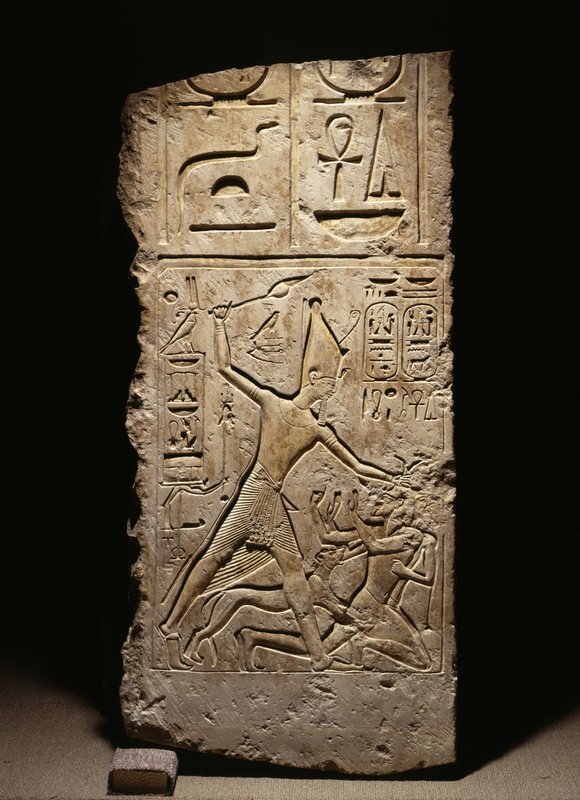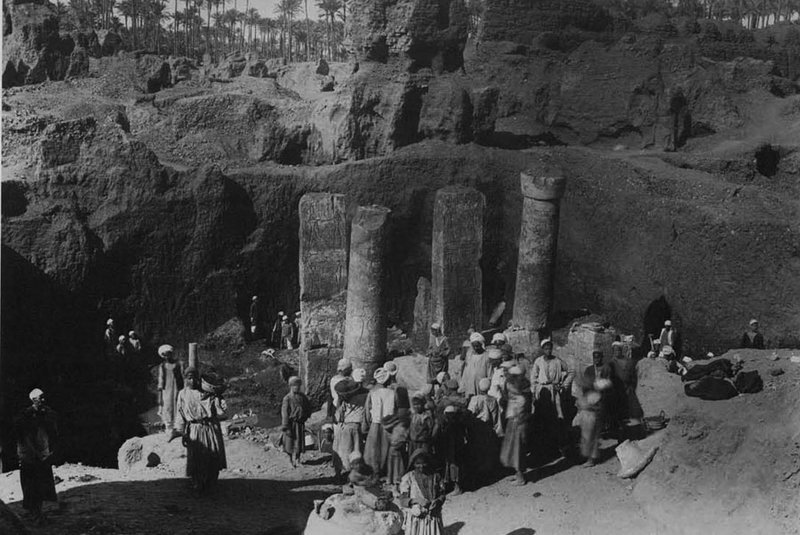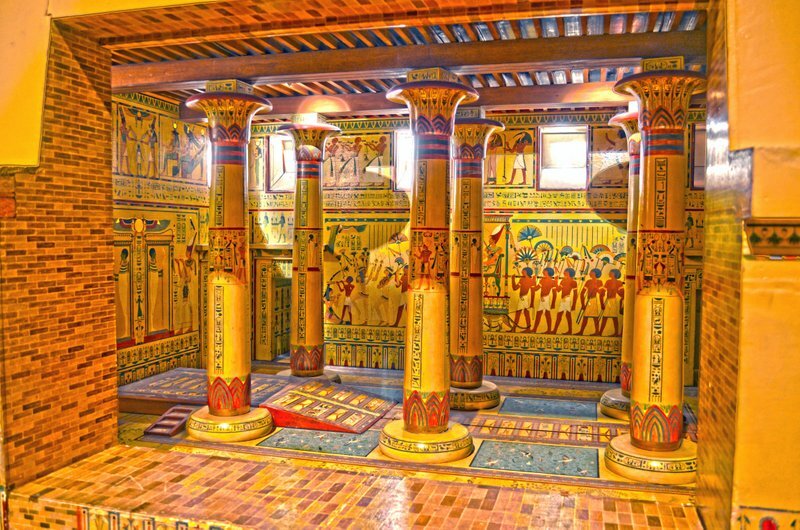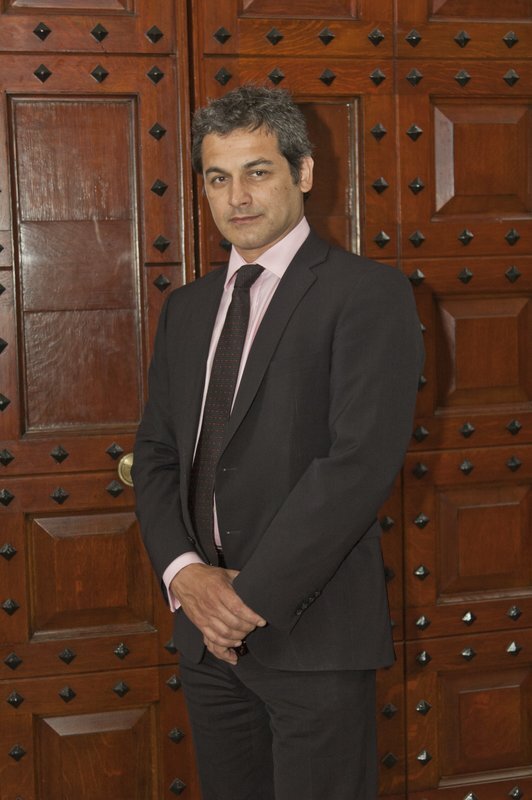
Any visitor would find it difficult to miss the Penn Museum’s iconic red granite sphinx. Resting center stage in the museum’s Lower Egyptian Gallery space, one doesn’t need to know that its estimated 15 tons of stone make it massive—the eyes already have it. It is touted as the third largest known sphinx in the Western Hemisphere. Originally quarried at Aswan by the ancients over 3,000 years ago in Upper Egypt, it was then floated down the Nile river to grace the sacred enclosure of Ramesses II’s Temple to Ptah at ancient Memphis.
Despite its incredible workmanship, however, the face of this sphinx can no longer be seen. It has long been eroded away by windblown sand over centuries of exposure. But from the shoulders down, details remain in place, that portion having been buried by sand and time and protected. One can still see inscriptions carved on its chest and about its base, looking almost as if they had been carved yesterday.
Surrounding the sphinx are the monumental reminders of another ancient pharaoh. Known as Merenptah, he was the 13th son of Ramesses II, having succeeded his father to the throne at a relatively advanced age and ruling for almost 10 years. Some of the monumental elements of his palace—massive partial columns, a gateway, doorframes, and lintels—which once stood pristine, complete, and fully painted near the Temple of Ptah and its sanctuary where the sphinx stood millennia before—are artfully represented. They constitute the most substantial assemblage of an ancient Egyptian palace in any single collection in the world.
___________________________________
 In the Penn Museum’s Egypt (Sphinx) Gallery, visitors can view the 15-ton Sphinx and its surrounding pillars and gateways, which date back to the 19th Dynasty (ca. 2393-2285 BCE) in Memphis, Egypt. The Sphinx of Ramesses II was excavated from the sacred enclosure of the temple of the god Ptah. The pillars and gateways were part of the palace of Merenptah. Photo image courtesy Penn Museum
In the Penn Museum’s Egypt (Sphinx) Gallery, visitors can view the 15-ton Sphinx and its surrounding pillars and gateways, which date back to the 19th Dynasty (ca. 2393-2285 BCE) in Memphis, Egypt. The Sphinx of Ramesses II was excavated from the sacred enclosure of the temple of the god Ptah. The pillars and gateways were part of the palace of Merenptah. Photo image courtesy Penn Museum
________________________________
 But there is more to this assembly than meets the visitor’s eye. Part of it remains in storage. And Penn Museum (short for University of Pennsylvania Museum of Archaeology and Anthropology) Director Julian Siggers has big plans for it, along with many other exhibition spaces at the museum.
But there is more to this assembly than meets the visitor’s eye. Part of it remains in storage. And Penn Museum (short for University of Pennsylvania Museum of Archaeology and Anthropology) Director Julian Siggers has big plans for it, along with many other exhibition spaces at the museum.
“What we are to embark upon is the most ambitious renovation this museum has ever seen,” said Siggers, speaking of his vision to completely reinstall some of the museum’s signature galleries. “And in our basement we have a New Kingdom palace, the palace of Merenptah, and central to our plans is to install the throne room of the palace, complete with the full columns.”
The plan harkens back to an earlier time, when, in the early 20th century Penn Museum archaeologist Clarence Fisher conducted excavations at a site in ancient Memphis that contained clues of a royal structure. By 1915, he and his work team had uncovered the major elements of what he identified as the Palace of Merenptah. More than 50 tons of excavated material, consisting of massive architectural elements such as columns, a monumental gateway, lintels, and doorframes, eventually made their way back to the Penn Museum in 1924 (see doorjamb example, above). Museum planners and curators were anxious to get these spectacular finds on display for the world to see, and thus a 3rd floor gallery space was prepared for the exhibition.
__________________________________
 Above, Merenptah’s palace being uncovered during the excavation in 1915. Below, the throne room of the palace emerges. Courtesy Penn Museum archives.
Above, Merenptah’s palace being uncovered during the excavation in 1915. Below, the throne room of the palace emerges. Courtesy Penn Museum archives.
________________________________
 Merenptah’s throne room emerges during excaations in 1915. Courtesy Penn Museum archives.
Merenptah’s throne room emerges during excaations in 1915. Courtesy Penn Museum archives.
_______________________________
But their initial vision could not be met. As it turned out, the gallery floor structure was not strong enough to sustain the weight of the massive objects. “The ceiling height was originally designed in the ’30’s to accommodate the full-length columns, but they miscalculated the floor carrying capacity,” said Siggers. The collection was moved to a first floor gallery, where they are seen today along with the sphinx—but only in part. The columns, for example, can only be seen as fragments or sections of their original form. Unseen elements still rest in storage, where today they await plans to restore the columns and gateway elements to their full height in a grand realization of the original scale in the 3rd floor gallery space as originally intended. “We just completed a feasibility study of how we can actually reinforce that floor very cheaply,” Siggers added. The project is expected to take at least several years to complete, in tandem with the many other renovation projects on the agenda.
The throne room reconstruction will be an apt tribute to a man who, like many of the pharaohs who came before and after him, made a clear imprint on Egyptian history. He is known to have carried out several military campaigns during his rule. In the 5th year of his reign he battled the Libyans, who, along with the help of the Sea Peoples, were challenging his kingdom from the West. He led a successful battle against the combined Libyan and Sea People forces at the city of Perire. Regarding another military theater, the ‘Merneptah Stele‘, also known as the ‘Israel Stele‘, documents his victorious campaign in Canaan, where he boasts to have laid waste to the inhabitants there, including the ‘people of the book’: “Israel has been wiped out…its seed is no more.” He escaped death on the battlefield, having died an old man, suffering from arthritis and arteriosclerosis. His remains, which were found in 1898 with a mummy cache of eighteen other mummies in the tomb of Amenhotep II (KV35) by Victor Loret, were transferred to Cairo and unwrapped and examined by G. Elliott Smith in 1907. Smith wrote:
The body is that of an old man and is 1 meter 714 millimeters in height. Merenptah was almost completely bald, only a narrow fringe of white hair (now cut so close as to be seen only with difficulty) remaining on the temples and occiput. A few short (about 2 mill) black hairs were found on the upper lip and scattered, closely clipped hairs on the cheeks and chin. The general aspect of the face recalls that of Ramesses II, but the form of the cranium and the measurements of the face much more nearly agree with those of his [grand]father, Seti the Great.*
Adjacent to the current gallery holding the Merenptah palace objects is a space exhibiting a small-scale artist’s model reconstruction of the throne room as it would have appeared in Merenptah’s day. Unlike the real, full-scale remains displayed nearby, it is brightly illustrated with the colors and symbols that would have adorned walls, columns and other architectural elements of the time. But it can’t compare in originality, feel and grandeur to the actual monuments nearby. In this sense, actually ‘seeing is believing’—and putting it all together, at last, will be a perfect closure to a resurrection that began almost 100 years ago.
Merenptah would be proud.
_________________________________
 An original watercolor reconstruction of the Throne Room of the Palace of Merenptah, painted by Mary Louise Baker, 1920. Image courtesy Penn Museum Archives.
An original watercolor reconstruction of the Throne Room of the Palace of Merenptah, painted by Mary Louise Baker, 1920. Image courtesy Penn Museum Archives.
_____________________________________________
 An interior view of a model depicting a modern reconstruction of the Throne Room of the Palace of Merenptah, created in the 1930s by Mary Louise Baker. Photo image courtesy PennMuseum.
An interior view of a model depicting a modern reconstruction of the Throne Room of the Palace of Merenptah, created in the 1930s by Mary Louise Baker. Photo image courtesy PennMuseum.
_______________________________________________
Image third from top, right: Limestone door jamb from Palace of Merenptah, depicting the pharaoh in smiting pose defeating Asiatic enemies. Courtesy Penn Museum.
* Grafton Elliot Smith, The Royal Mummies, Cairo (1912), pp. 65-70
________________________________________________
A R T I C L E S U P P L E M E N T
THE PENN MUSEUM’S BIG PLANS
____________________________________
 Julian Siggers is a man with a vision. Since assuming his responsibilities as the Williams Director of the University of Pennsylvania Museum of Archaeology and Anthropology in July of 2012, he has begun to reshape, in both institutional mission and physical layout, the museum’s face to the world.
Julian Siggers is a man with a vision. Since assuming his responsibilities as the Williams Director of the University of Pennsylvania Museum of Archaeology and Anthropology in July of 2012, he has begun to reshape, in both institutional mission and physical layout, the museum’s face to the world.
“I knew about this museum when I was an undergraduate in London,” says Siggers. “But even earlier, as a teenager my parents gave me a copy of Gods, Graves and Scholars, and one of the key stories it relates is the story of Ur, which of course is the account of the Penn Museum’s excavations there. So when I came here it was this incredible opportunity, because the focus of this museum, as a University museum, is of course research.”
It is thus Siggers’ dream to share this excitement of discovery through research with the public, launched from the foundation of it’s new mission statement, The Penn Museum transforms understanding of the human experience.
“What I have been able to do is work on a new strategic plan, and central to that is the reinstallation of some of our signature galleries, which includes our Egyptian galleries, our Asian *galleries, and our Near Eastern galleries,” Siggers continues. “These are some of the areas where our greatest excavations have been conducted. We’re going to bring the excitement of discovery into the galleries by redesigning everything and rethinking it from the ground up.”
It will mean presenting the objects in a chronological historical context so that visitors can understand the material culture as it developed in the timeline of human history. But what is more, it will be about telling the story of how and where they were discovered and who discovered them.
“Often when one goes to museums, the galleries are actually developed by departments, and they don’t reflect how one should properly tell the story of the past,” he explains. “I’m hoping to have more of a continuous story. But the thing I most want to see in the new galleries is to show how dynamic the process of discovery is. Right now we have all of these field projects, with people in Kurdistan, Egypt, Turkey, France, and Mesoamerica, and they’re coming back with these wonderful discoveries, and so we need to find a way to get these discoveries in the gallery.”
But Siggers’ new strategic plan goes beyond the gallery renovations. Two other initiatives will emphasize the museum’s prime traditions as a research and educational institution. The first will capitalize on the museum’s strength as a teaching and research institution—establishment of the Center for the Analysis of Archaeological Materials. In collaboration with the University of Pennsylvania’s School of Arts and Sciences, it is hoped that it will become a premier center for the teaching of archaeological science. The second, reaching out to potential future generations of archaeologists and history enthusiasts, involves a new partnership with the School District of Philadelphia. Bringing the fascination of archaeology and ancient history to the youth will be a major focus of the museum’s ongoing mission for public outreach and local engagement. It “will serve every 7th grade public school student in the city,” state museum officials.*
In the end, Siggers feels that the science and contribution of archaeology is not only about discovery—it’s about translating it from the exclusive halls of academia and the specially equipped labs to those who ultimately matter the most in terms of understanding the human past—the inquisitive, appreciative public and future generations.
______________________________________________
* Building Transformation: A Strategic Plan for the Penn Museum 2013 – 2020, Expedition Magazine, Spring 2014, Volume 56, No. 1, p. 59
Photo image of Julian Siggers courtesy Penn Museum.
__________________________________________________________________________





